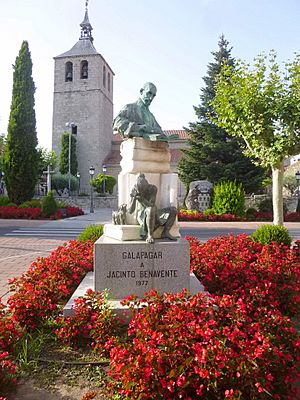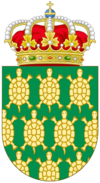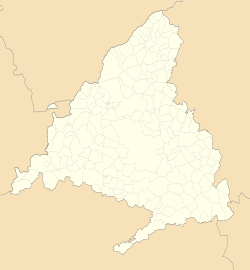Galapagar facts for kids
Quick facts for kids
Galapagar
|
|||
|---|---|---|---|

City centre of Galapagar; the sculpture is by Luis Sanguino.
|
|||
|
|||
| Country | Spain | ||
| Community | Community of Madrid | ||
| Province | Madrid | ||
| Comarca | Guadarrama | ||
| Area | |||
| • Total | 65 km2 (25 sq mi) | ||
| Elevation | 881 m (2,890 ft) | ||
| Population
(2018)
|
|||
| • Total | 33,379 | ||
| • Density | 514/km2 (1,330/sq mi) | ||
| Demonym(s) | Galapagueños | ||
| Time zone | UTC+1 (CET) | ||
| • Summer (DST) | UTC+2 (CEST) | ||
| Postal code |
28260
|
||
Galapagar is a town and municipality located northwest of Madrid, Spain. It is part of the Community of Madrid, which is an autonomous community in Spain. Galapagar has been growing quickly, mostly because more people are moving there. Old fields used for livestock are being turned into areas for new buildings.
Galapagar shares its borders with several other towns. These include Collado Villalba, Colmenarejo, Torrelodones, Las Rozas de Madrid, El Escorial, San Lorenzo de El Escorial, Villanueva del Pardillo, Hoyo de Manzanares, Moralzarzal, and Guadarrama.
Contents
The History of Galapagar
The name Galapagar comes from the Spanish word galápago, which means "turtle". The town center was first built near a lake that had many turtles.
Early Beginnings
Galapagar first appeared as a small village in the 11th century. It became important because the Spanish royal family often visited for hunting trips. It was also a key stop on the road from the capital city to the Royal Monastery of San Lorenzo de El Escorial.
Notable Landmarks
One important sight in Galapagar is the church of The Asunción, also known as the Assumption. This historic church is a significant part of the town's heritage.
Getting Around Galapagar
Galapagar has good public transport connections.
Train Services
The town is served by the Cercanías Madrid commuter rail service. You can catch trains on lines C-3, C-8, and C-10 from the Galapagar-La Navata train station. These lines connect the town to other areas.
Bus Connections
There are also nine different interurban bus lines. These buses link Galapagar to the Moncloa district in Madrid, making it easy to travel to the capital.
Famous People from Galapagar
Galapagar is known for a few famous individuals.
Jacinto Benavente was a very important Spanish writer of plays in the 20th century. He won the Nobel Prize in Literature in 1922. He is buried in Galapagar.
José Tomás
The famous bullfighter José Tomás was born in Galapagar.
Local Traditions and Economy
Galapagar has strong ties to traditional Spanish culture and its local economy.
Bullfighting and Livestock
Bullfighting is a notable part of the town's culture. Stock-breeding, which means raising animals like cattle, is also very important. The area is known for its meadows and beef production.
See also
 In Spanish: Galapagar para niños
In Spanish: Galapagar para niños





